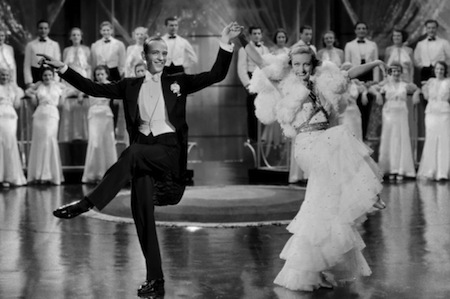Born: May 10, 1899, Omaha, NE
Died: June 22, 1987, Los Angeles, CA
To be in a picture with Fred Astaire was every dancing girl’s dream.
—Ann Miller
Fred Astaire’s spirited, inventive dancing was characterized by crisp, coordinated steps. He rehearsed extensively and demanded his partner share his dedication. During the Depression and World War II, Astaire distracted millions of troubled minds by dancing up the walls, over the furniture, on roller skates and in costumes that ranged from the dapper tuxedo of a gentleman to the disheveled rags of a hobo. He is remembered as the quintessential hoofer, a talented man of modest looks who turned his sense of timing and humble charm into a ticket to stardom. More important, his happy-go-lucky demeanor assured Depression-era crowds that prosperity truly was just around the corner.
Fred was dancing at age four and touring the vaudeville circuit at age seven; his first successful partnership was with his sister Adele. In 1917, the Astaire siblings tapped into international fame with such Broadway hits as Funny Face (1927) and Band Wagon (1931). Adele tired of dancing in 1932, and Fred had to find a new partner.
After a famously unflattering Hollywood test, Fred first stepped onto the screen in an obscure number with Joan Crawford in Dancing Lady (1933). Later that year, he appeared with Ginger Rogers in Flying Down to Rio, their first of their ten films, which included The Gay Divorcee (1934), Top Hat (1935) and Swing Time (1936). Their routines started international dance crazes, notably the revival of interest in the carioca and fandango, but they were more closely associated with an intimate style of dance that provided an upbeat distraction from the sour spirits of the stock crash. Astaire personally outlined the routines and trained Rogers to keep in step with him. Up on the screen, in perfect harmony, Rogers and Astaire seemed effortless and elegant, caught in a timeless celebration that embodied hope and harmony.
Although exuberance was the key to Astaire’s success, he was also driven to experiment with the wide-open possibilities of dancing in films. He choreographed sequences in which the camera turned over to follow him up the walls of a room and across a ceiling; he incorporated firecrackers into tap routines. More fundamentally, he revolutionized the structure of the genre.
Before Astaire, movie musicals were simply revues, a smattering of individual songs and spectacular dance numbers. The films of Busby Berkeley, with their elaborate stage sets and casts of thousands, were the touchstone. MGM’s musicals existed primarily to showcase Broadway sensations or present-day hit recordings. Astaire saw other possibilities. He integrated songs and intimate “celebratory” dances that reinforced the plot points or themes of the script. He made his films more story than song and brought sophistication to the musical, substantially revising a long-standing tradition in the movies. Stars of the old-school films, like Al Jolson and Eddie Cantor, saw their popularity wane; musical directors who could not adapt to the integration, like Berkeley himself, found their projects financially undesirable to studios.
In 1946, Astaire temporarily retired; long rehearsals and personal travails had taken their toll, and he required an extended break. After his return, hits such as Easter Parade (1948), Daddy Long Legs (1955) and Silk Stockings (1957) marked Astaire’s passage through the brilliant Technicolor era. His partners changed as often as his costumes: Eleanor Powell, Lucille Bremer, Judy Garland, Cyd Charisse, Audrey Hepburn, Leslie Caron, Ann Miller, Vera-Ellen, Barrie Chase and his personal favorite of them all, Rita Hayworth. He served as an inspiration for the next wave of screen dancers; talents as diverse as Mikhail Baryshnikov, Patrick Swayze and Gregory Hines credit his example. Inanimate objects often served as willing dance partners: tables, chairs, revolving doors, golf clubs, hat racks. These imaginative routines challenge the creativity of his contemporaries; the legendary Gene Kelly spoke of Astaire as “one of the greatest dancers who ever lived.”
In 1949, Astaire was honored with a special Academy Award for his contributions to musical film. He stopped dancing in 1971 but continued to act in films into the early eighties. The Astaire musical, with its unmatched grace and sophistication, still left plenty of room for the imagination of modern choreographers like Bob Fosse, but Fred Astaire’s technical excellence is still regarded as the greatest in the history of film.
To read all the republished articles from ‘The Film 100,’ go to Reintroducing the Film 100 here on Keyframe.





